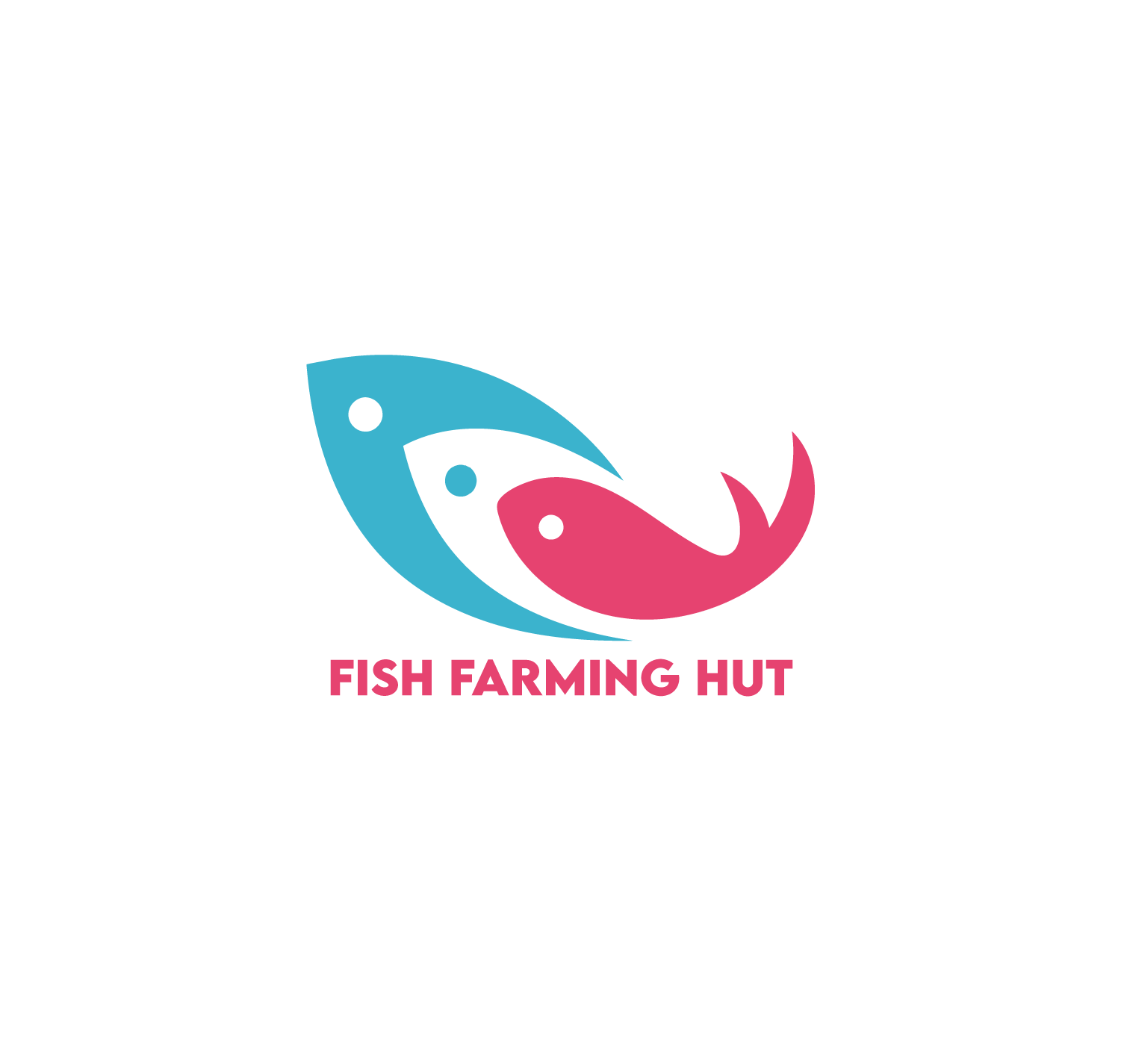Given that fish farming and aquaculture are growing in popularity and are expected to expand in light of the demand for improved food security, it is unsurprising that one needs a lot of skills, knowledge, training, and aptitude to excel in this growing profession. So how does one become a fish farmer?
The following is necessary to become a fish farmer:
- A bachelor’s diploma in aquaculture or training through the National Aquaculture Association,
- A natural aptitude for farm work and long hours,
- Significant startup capital (for individual projects),
- Compliance with all federal/state laws.
Although becoming a fish farmer may seem like a daunting task, it is a fulfilling career with plenty of professional growth for people with an aptitude for biology, attention to detail, and who enjoy facing a host of challenges for extended periods. Let’s explore these requirements in more detail below:
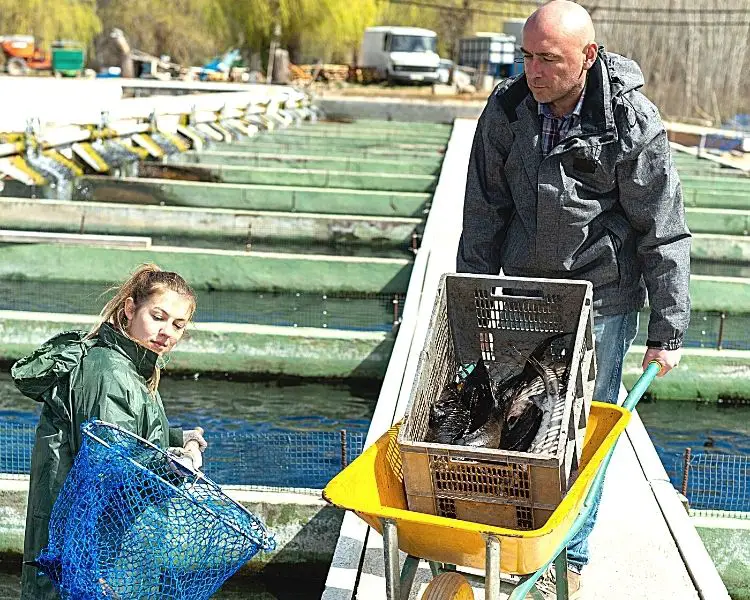
What Formal Education Do You Need To Become A Fish Farmer?
Unlike traditional farming methods or small-scale subsistence farming or any other operations, becoming a fish farmer requires an individual to study aquaculture and biology at the equivalent of a bachelor’s level at university/college (although some farmers take up apprenticeships with a high-school diploma.)
Aquaculture involves any aspect of breeding, raising, or processing aquatic animals and plants for consumption, ornament, or for release. Fish farming is generally conducted in artificially contained water habitats, ponds, oceans, or coastal waters subject to controlled conditions.
Aquaculture farmers are knowledgeable in the life cycle and the biology of the species they farm. Therefore, it is essential to independently study and research any or all species you intend to farm, regardless of any formal qualifications you may have.
Fish farmers must know how to treat diseases and maintain the proper environment for plants and animals to ensure maximum production and health. They must also comply with all federal and state regulations associated with aquaculture farming, whereby the study of these laws is recommended.
Although fish farmers can learn on the job with a high school diploma, those that wish to involve themselves in large commercial farms or start their own operations will need a college diploma or a similar formal qualification from the National Aquaculture Association.
Typically speaking, college diplomas fall under the agriculture or biology departments. Therefore, most aquaculture diplomas will include in-depth study in biology, microbiology, parasitology, ichthyology, and fishery and hatchery management.
Furthermore, practical skills training or an internship with a professional fish farmer are necessary to secure a formal college degree. To assist with the practical requirement and to develop one’s skills, mentorship programs are available.
Mentorship programs are usually available via state agencies, state extension offices, and local organizations.
Unsurprisingly most of the top aquaculture diplomas are offered at southern state colleges:
What Skills And Responsibilities Make A Good Fish Farmer?
Generally speaking, being a fish farmer involves a unique combination of autonomous skills and responsibilities that require an individual to display a consistent work ethic.
Some of the key skills and responsibilities of fish farmers are:
Therefore, while academic qualifications and skills are important, various natural skills, adaptability, “soft skills,” and business sense are needed to be a successful commercial fish farmer.
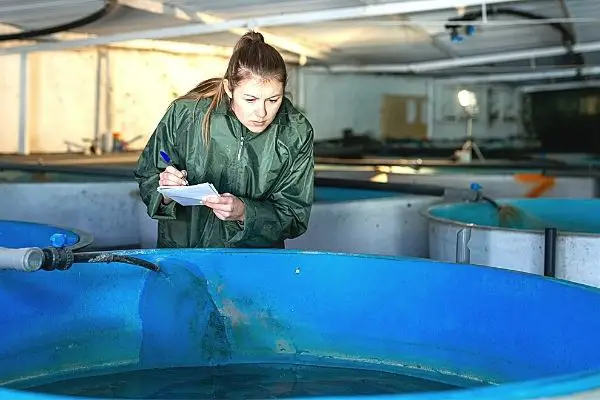
Fish Farmer checking fish growth in indoor fish tank
What Is A Typical Day In The Life Of A Fish Farmer Like?
Like many other jobs in agriculture, becoming a fish farmer is less of a profession and more of a lifestyle. Consequently, fish farmers seldom take days off and are expected to work very long hours.
Day-to-day duties of fish farmers include, but are not limited to:
For a visualization of the type of work fish farmers do, the conditions they expose themselves to, and the challenges of long hours, feel free to follow the link to Korda TV Carp Fishing’s video “The Life of a Fish Farmer – Team Korda”:
What Are The Different Methods Of Fish Farming?
Once you qualify as a fish farmer and develop the necessary skills for fish farming, you need to consider which type of fish farming you will do. There are three common methods of commercial fish farming you can use:
- Cage system
- Pond system
- Integrated recycling system
1. Cage System
Otherwise known as offshore cultivation, this method uses cages in lakes, ponds, rivers, and the ocean to artificially house and care for fish in a natural environment.
The cage system is an easy and affordable method of fish farming that requires farmers to use a cage or pen made of plastic pipe and rigid netting moored in any suitable body of water stocked with fingerlings fed until they reach a harvestable size.

Fish Cage
While the standard costs involve cage materials, fish, and feed, there have been further advancements that can help you monitor and prevent diseases and environmental damage affecting your farmed fish.
Finally, you must be aware that the cage system always carries the risk of fish escaping and being let loose among the wild population. Therefore, it is crucial that any fish species you farm is native to the area where the cages are located to avoid the release of invasive species into natural bodies of water!
2. Pond System
As the name implies, pond systems require the construction and management of artificial ponds to house and care for your fish. While smaller ponds require the artificial feeding of fish and the recycling of waste as fertilizer, larger ponds are self-sustaining, resulting in the growth of plants and algae for food.
Although pond systems typically only allow for one species of fish, larger ponds can host various species of complimentary fish species in what is known as a composite fish culture.
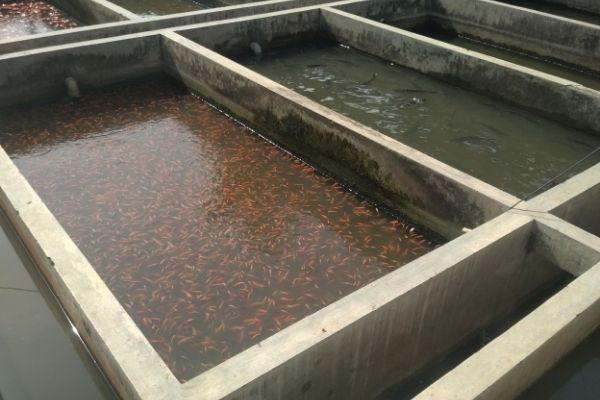
Finally, suppose you decide to create an artificial body of water by diverting a continuous source of naturally flowing water, such as a river, into artificial “raceways” that hold fish. In that case, these are known as flow-through systems, which share some similarities to the greater pond system of fish farming.
It is crucial to be aware that flow-through systems are subject to regulations regarding the diversion and use of natural water sources. Therefore you must consult local fish and soil conservation authorities before using nearby streams!
3. Integrated Recycling System
Sometimes referred to as a recirculating system, this method of fish farming is considered the largest scale method of “pure” commercial fish farming. An integrated recycling system involves using large plastic tanks placed inside greenhouses.
Located near these plastic tanks are hydroponic beds. The water from the plastic tanks is circulated through where the waste is recycled to provide nutrients to various crops in the hydroponic beds.
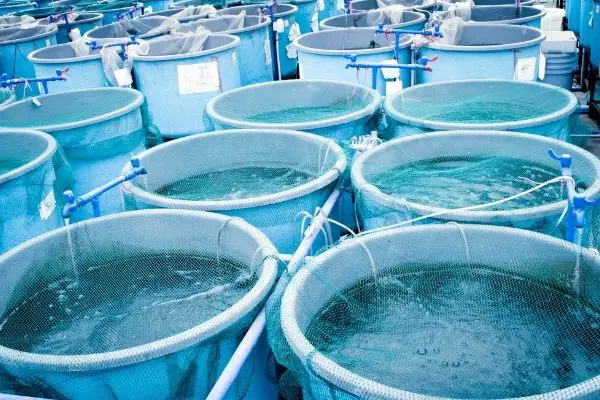
An intensive water quality monitoring program is vital, along with backup systems that can quickly stream new water through the system in emergencies. Unfortunately, unpleasant flavors are sometimes imparted to fish in these systems.
Consequently, while many believe that recirculating systems are the future of fish farming, they are expensive and complex farming methods that are seldom feasible for large-scale operations.
What Are The Startup Costs And Expenses?
Over and above the college fees to qualify with the necessary diploma to begin your fish farming journey, the costs of starting and maintaining a commercial fish farmer vary greatly depending on the size of the fish farm, the type of species farmed, and the method of farming.
Generally speaking, indoor tanks are cheaper than ponds at between $1,000 and $3,000, while outdoor ponds are roughly $2000 per square acre, meaning that ponds cost between $3,000 and $10,000.
Some basic needs and costs include oxygen, water, and food:
- Oxygen: maintaining oxygen levels is essential for indoor tanks and outdoor ponds. Aeration systems for tanks and ponds are between $1,000 and $3,500. In contrast, an integrated water recirculating system is significantly more at approximately $10,000 to over $100,000!
- Water: because commercial farms typically require over 15 gallons of water per minute per surface area of water, you need to create or find a source of affordable water, such as a well.
- Food: fish pellets, fish meal, and other food items are estimated at 70% of a commercial fish farm’s operational costs. Therefore, finding affordable supplies, making your food, or having a self-sustaining pond is recommended.
Finally, because of the possibility of disease, parasites, unpredictable weather, or equipment failure, you must take out comprehensive insurance to cover all costs in the event of widespread production failure.
What Are The Legal Requirements For Operating A Fish Farm?
There are various rules and regulations you need to comply with if you want to operate a commercial fish farm:
Registering For Tax
To register for state and federal taxes, you must apply for an EIN on the IRS website. When doing so, it is recommended that you have business accounts and software already in place to make the monitoring and reporting process as easy as possible.
Furthermore, as a business that supplies goods (in the form of different fish species), you will need to register for sales tax and record transactions accurately, depending on what species of fish and aquatic products you decide to sell.
In conclusion, you should seek the services of a tax professional to see how you can reduce your business expenses while remaining tax compliant.
Federal Business Licensing
The Food and Drug Administration determines federal regulations regarding the production and sale of food. Therefore, any fish stock you intend to sell as food or bait must comply with these regulations; it is advisable to seek an expert for legal and business advice to make sure you are compliant.
State And Local Business Licensing
Local business licensing and permits for commercial fish farms are governed by the National Oceanic and Atmospheric Administration Fisheries Service.
A starting point is to go to a local town council or clerk’s office, which should have the information you need to get the necessary business permits.
Certificate Of Occupancy
A Certificate of Occupancy is proof that the area you are using for a fish farm conforms to all building codes, zoning laws, and government regulations.
When leasing a property, the landlord usually has to manage the Certificate of Occupancy; however, you should have sight of this certificate before agreeing to a lease.
Suppose you purchase a property for commercial fishing. In that case, the Certificate of Occupancy becomes your duty of care, meaning that you should seek expert and legal advice to make sure all these requirements can be met before purchasing the property.
Conclusion
In conclusion, while fish farming may not appear at face value to be a highly technical or skilled profession, a fish farmer requires a unique combination of academic knowledge, resilience, problem-solving, and work ethic to succeed in this exciting and growing industry!
